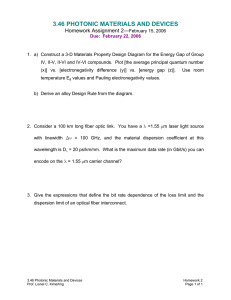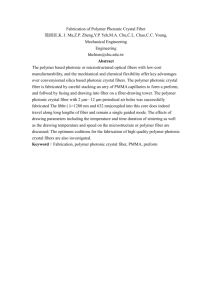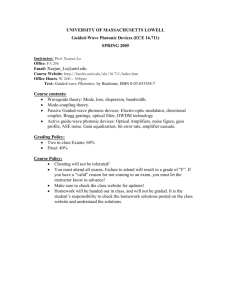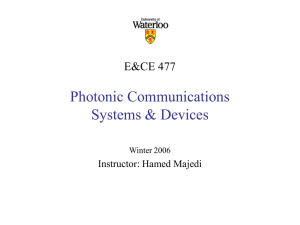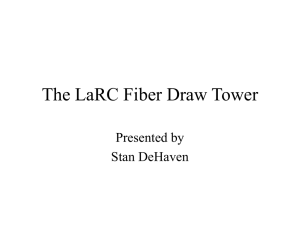ECE477_0 - Electrical and Computer Engineering
advertisement
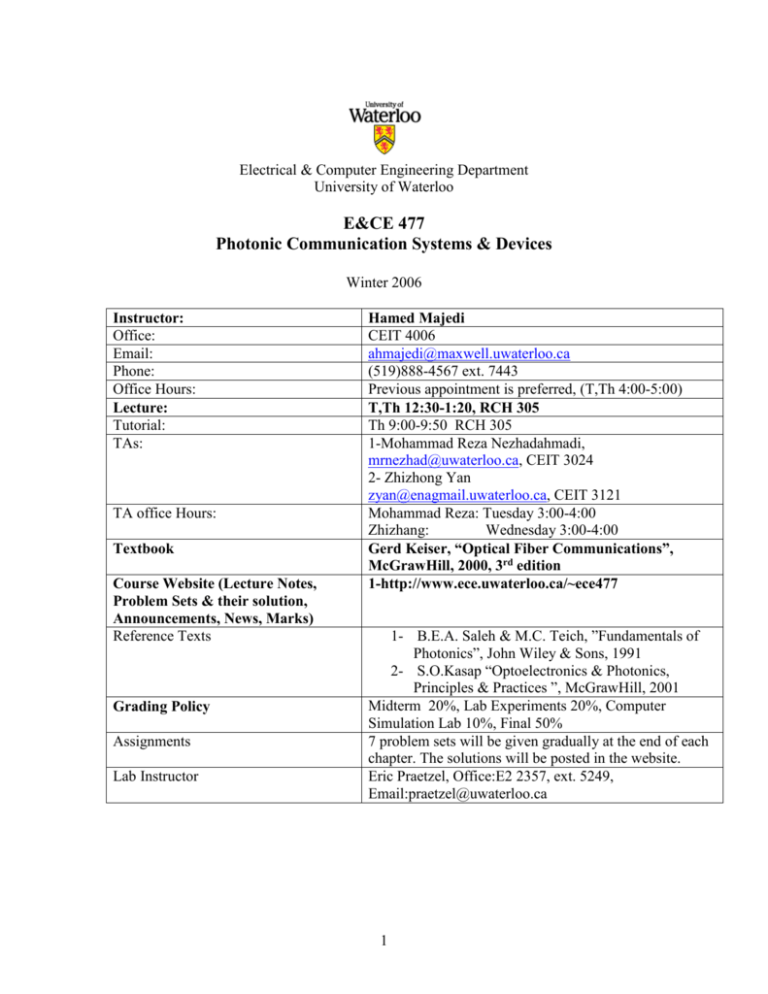
Electrical & Computer Engineering Department University of Waterloo E&CE 477 Photonic Communication Systems & Devices Winter 2006 Instructor: Office: Email: Phone: Office Hours: Lecture: Tutorial: TAs: TA office Hours: Textbook Course Website (Lecture Notes, Problem Sets & their solution, Announcements, News, Marks) Reference Texts Grading Policy Assignments Lab Instructor Hamed Majedi CEIT 4006 ahmajedi@maxwell.uwaterloo.ca (519)888-4567 ext. 7443 Previous appointment is preferred, (T,Th 4:00-5:00) T,Th 12:30-1:20, RCH 305 Th 9:00-9:50 RCH 305 1-Mohammad Reza Nezhadahmadi, mrnezhad@uwaterloo.ca, CEIT 3024 2- Zhizhong Yan zyan@enagmail.uwaterloo.ca, CEIT 3121 Mohammad Reza: Tuesday 3:00-4:00 Zhizhang: Wednesday 3:00-4:00 Gerd Keiser, “Optical Fiber Communications”, McGrawHill, 2000, 3rd edition 1-http://www.ece.uwaterloo.ca/~ece477 1- B.E.A. Saleh & M.C. Teich, ”Fundamentals of Photonics”, John Wiley & Sons, 1991 2- S.O.Kasap “Optoelectronics & Photonics, Principles & Practices ”, McGrawHill, 2001 Midterm 20%, Lab Experiments 20%, Computer Simulation Lab 10%, Final 50% 7 problem sets will be given gradually at the end of each chapter. The solutions will be posted in the website. Eric Praetzel, Office:E2 2357, ext. 5249, Email:praetzel@uwaterloo.ca 1 Tentative Schedule Week Date Topic 1 Jan 3, 5 2 Jan 10, 12 3 Jan 17, 19 4 Jan 24,26 5 Jan 31, Feb 2 6 Feb 7, 9 7 Feb 14,16 8 Feb 21, 23 Overview of Photonic Communication, Overview of EM waves Optical Fibers: Waveguiding & Propagation modes Mode Designation in Fiber optics, Single-mode Fibers, Signal Degradation in Optical Fibers (Loss and Dispersion) Various dispersion mechanisms in optical fiber and their characterization Photonic Sources & Transmitters: LED & Laser Diodes Single-Mode lasers, Modulation & Noise Laser-Fiber Connection 9 Feb 28, March 2 Fiber to Fiber joints, splicers,& connectors 10 March 7, 9 Photodetectors 11 Digital Photonic Receivers 12 March 16, 21 March 23 13 March 28,30 Analog Photonic receivers, point-to point-links WDM, Photonic Networks 2 Reading Textbook Home work 1.1, 1.2,1.3 2.1,2.2,2.3,2.4.1, 2.4.2, 2.4.7,2.4.8 2.5,2.7,2.8,2.10 Problem set #1 3.1,3.2,3.5 Problem set #2 4.1,4.2,4.3 Problem set #3 4.4,4.5 Problem set #4 Review for midterm 5.1.1, 5.1.2, 5.2(pp.212), 5.2.2 5.3,5.5.1, 5.6 (pp231&232), 5.6.3 (without eqs) 6.1,6.2,6.3.1,6.3.2,6. 5,6.7 7.1.1,7.1.2,7.1.3, 7.2.1 7.5,8.1 10.1,10.2.1,12.1, 12.2.3,12.2.4,12.3.1, 12.3.2,12.4.1 Midterm Friday Feb. 24, 3:00-5:00 Problem set #5 Problem set #6 Problem set #7 Course Objectives: This course addresses the physical principles for important optical devices and modules as well as their application in photonic circuits and systems. The main application focus is optical fiber communication systems and networks. Course Expectations: Learning is a cooperative task and students must participate actively. The students are expected to come to lecture, tutorials & lab sessions prepared to think and learn. The lecture period will be used to introduce and establish fundamental concepts. The tutorials will be used to practice engineering skills of problem solving and data acquisition and analysis. You should discuss your problems regarding concepts with the instructor during his office hours and talk to the TA regarding your difficulties with problem sets and lab reports & also contact the lab instructor for problems with lab experiments. Obviously, TA will also help you to understand basic concepts. To get the most out of the lectures and tutorials, you need to read sections of the textbook assigned in the tentative schedule, and go over the examples in those sections. You are encouraged to work in groups and discuss the homework. Note 1: The lab sessions will start at the beginning of March. There will be three experiments regarding fiber spectral attenuation & dispersion measurements. You have to log in to the http://ece.uwaterloo.ca/signup.html to form your group and sign up for lab sessions. Each group should be formed by 4 students. The due date to hand in the lab reports to the TA is Mar 30, 2006. Note 2: There will be 6 nice & easy computer simulations using Photonic Transmission Design Suite 1.1 Lite, the CD included with your textbook. The TA will teach you how to use this CD & post an example for every 6 simulations in the course website. He will give you questions regarding each simulation & explain how you should hand in your computer simulations. The due date to hand in your computer assignments is March 31. The total estimated time to do this computer simulations and preparing the report is about 3 hours. The list of computer simulations is as follows: 1- Bit error rate estimation of digital single channel fiber optic link 2- Influence of fiber dispersion on the bit error rate 3- Fiber dispersion compensation by three different methods 4- 4 channel WDM transmission by four wave mixing 5- Comparison of external vs. direct laser modulation for various bit rate 6- 2 channel WDM add/drop multiplexer using fiber Bragg gratings & circulators. Note 3: The graduate students who take this course for credit should talk to the instructor. They must solve and hand in all the problems & do a term project. 3
